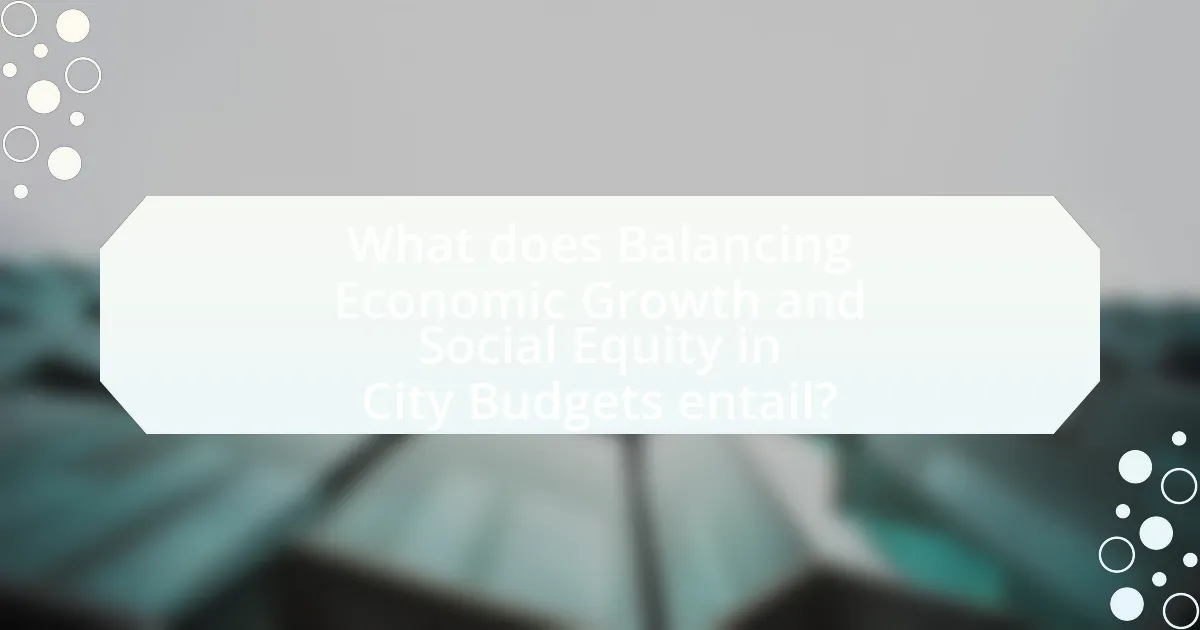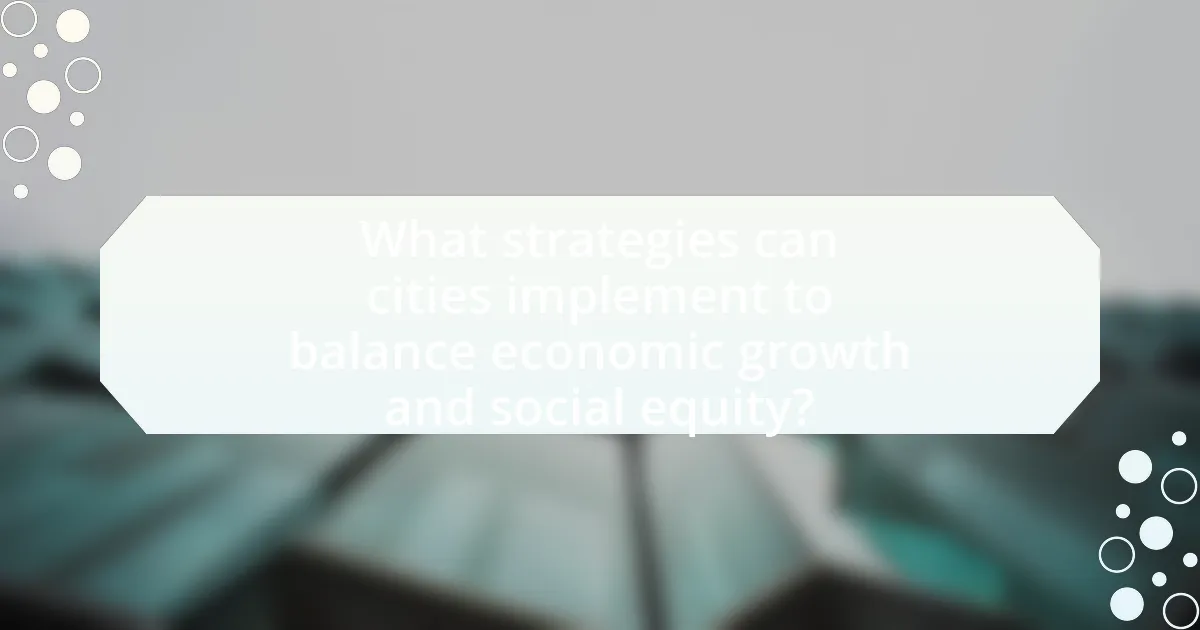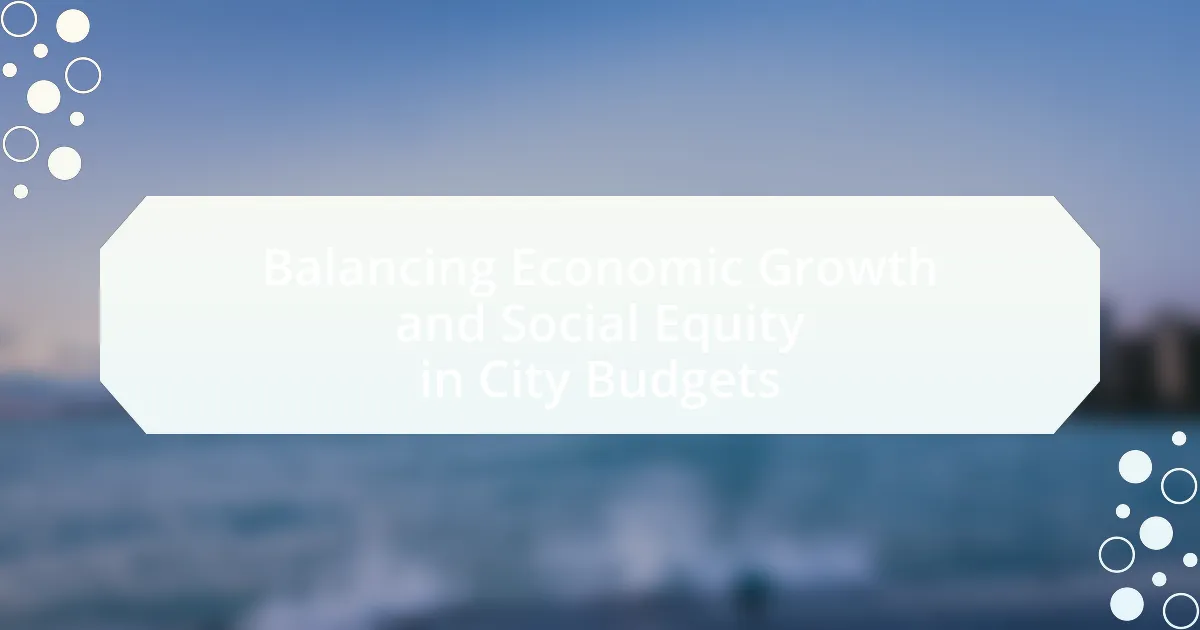Balancing economic growth and social equity in city budgets involves the strategic allocation of financial resources to foster both development and equitable access to services for all community members. This article examines the interaction between economic growth and social equity within city budgets, highlighting key indicators of growth, methods for measuring equity, and the importance of a balanced approach. It discusses the challenges cities face in achieving this balance, strategies for inclusive budgeting, and the role of community engagement in decision-making processes. Additionally, it explores successful case studies and practical steps city officials can take to ensure ongoing balance between economic development and social equity.

What does Balancing Economic Growth and Social Equity in City Budgets entail?
Balancing economic growth and social equity in city budgets entails allocating financial resources in a manner that promotes both economic development and equitable access to services for all community members. This approach requires city officials to prioritize investments that stimulate job creation and infrastructure improvements while ensuring that marginalized populations receive adequate support and opportunities. For instance, cities may implement policies that direct funding towards affordable housing, public transportation, and education, which can help reduce disparities. Research indicates that cities that successfully balance these priorities often experience enhanced social cohesion and sustainable economic growth, as evidenced by studies showing that equitable investment leads to improved overall community well-being and economic resilience.
How do economic growth and social equity interact within city budgets?
Economic growth and social equity interact within city budgets by influencing resource allocation and prioritization of services. When cities experience economic growth, they often have increased revenues from taxes and investments, which can be allocated to enhance public services and infrastructure. However, if the focus is solely on growth, it may lead to disparities, as marginalized communities might not benefit equally from these investments. For instance, a study by the Urban Institute found that cities that prioritize equitable spending can reduce income inequality and improve access to essential services, demonstrating that balanced budget strategies can foster both growth and equity. Thus, effective city budgeting requires a dual focus on fostering economic development while ensuring that all community members share in the benefits.
What are the key indicators of economic growth in city budgets?
Key indicators of economic growth in city budgets include revenue growth, employment rates, and infrastructure investment. Revenue growth reflects the city’s ability to generate income through taxes and fees, indicating a robust economy. Employment rates show the number of jobs created, which directly correlates with economic activity and prosperity. Infrastructure investment demonstrates the city’s commitment to improving facilities and services, which can attract businesses and residents, further stimulating economic growth. These indicators are essential for assessing the overall economic health and sustainability of a city.
How is social equity measured in the context of city budgets?
Social equity in the context of city budgets is measured through the analysis of resource allocation and its impact on various demographic groups. This involves assessing how budgetary decisions affect access to services such as education, healthcare, housing, and transportation for marginalized communities. For instance, cities may utilize equity assessments to evaluate whether funding is distributed in a manner that addresses disparities, ensuring that historically underserved populations receive adequate support. Data from the Government Finance Officers Association indicates that cities employing equity metrics in budgeting can identify gaps in service delivery and prioritize investments that promote inclusivity and fairness.
Why is it important to balance economic growth and social equity?
Balancing economic growth and social equity is crucial because it ensures that the benefits of growth are distributed fairly across all segments of society. When economic growth occurs without regard for social equity, disparities in wealth and opportunity can widen, leading to social unrest and decreased overall well-being. For instance, according to a report by the International Monetary Fund, countries with higher income inequality tend to experience slower economic growth over time. This correlation highlights the importance of integrating social equity into economic policies to foster sustainable development and social cohesion.
What are the potential consequences of prioritizing one over the other?
Prioritizing economic growth over social equity can lead to increased income inequality and social unrest. When city budgets focus primarily on growth, essential services such as education and healthcare may receive insufficient funding, exacerbating disparities among different socioeconomic groups. For instance, a study by the International Monetary Fund in 2015 found that higher income inequality can hinder economic growth, creating a cycle where the benefits of growth are not equitably shared. Conversely, prioritizing social equity can result in slower economic growth if resources are diverted from development projects. This trade-off can lead to a lack of investment in infrastructure and job creation, ultimately affecting the city’s overall economic health.
How can a balanced approach benefit the overall community?
A balanced approach can benefit the overall community by ensuring that economic growth does not come at the expense of social equity. This approach promotes inclusive development, where resources are allocated to both infrastructure and social services, leading to improved quality of life for all residents. For instance, cities that invest in affordable housing alongside commercial development see reduced homelessness and increased community stability, as evidenced by studies showing that balanced budgets can lead to a 20% decrease in poverty rates over a decade. By prioritizing both economic and social needs, communities can foster a more resilient and cohesive environment, ultimately enhancing social cohesion and reducing disparities.
What challenges do cities face in achieving this balance?
Cities face significant challenges in balancing economic growth and social equity in their budgets. One major challenge is the allocation of limited financial resources, which often prioritizes economic development projects over social programs, leading to disparities in community support. Additionally, cities must navigate conflicting interests among stakeholders, including businesses, residents, and advocacy groups, which can complicate decision-making processes. Furthermore, the pressure to attract investment can result in policies that favor affluent areas, exacerbating inequality in less wealthy neighborhoods. Data from the National League of Cities indicates that 70% of city leaders report difficulty in addressing social equity while pursuing economic initiatives, highlighting the systemic nature of these challenges.
What are common obstacles in budget allocation for economic growth?
Common obstacles in budget allocation for economic growth include limited financial resources, competing priorities, and lack of data-driven decision-making. Limited financial resources restrict the ability of governments to invest adequately in infrastructure and services that promote growth. Competing priorities arise when different sectors, such as education and healthcare, vie for the same budget, often sidelining economic development initiatives. Additionally, the absence of robust data can hinder effective planning and allocation, leading to inefficient use of funds. For instance, a report by the International Monetary Fund highlights that countries with better data management systems tend to allocate budgets more effectively towards growth-oriented projects.
How do social equity concerns complicate budget decisions?
Social equity concerns complicate budget decisions by necessitating the allocation of resources in a way that addresses disparities among different demographic groups. When city budgets are developed, policymakers must consider how funding decisions impact marginalized communities, which can lead to conflicts between economic growth initiatives and the need for equitable service distribution. For example, prioritizing infrastructure projects that benefit affluent areas may exacerbate inequalities, prompting calls for more inclusive budgeting practices. Research indicates that cities implementing participatory budgeting processes, where community members influence budget allocations, have seen improved social equity outcomes, demonstrating the complexity of balancing diverse needs within budgetary constraints.

What strategies can cities implement to balance economic growth and social equity?
Cities can implement inclusive zoning policies to balance economic growth and social equity. Inclusive zoning requires developers to allocate a percentage of new housing units as affordable, ensuring that low- and moderate-income residents can access housing in growing areas. For instance, cities like San Francisco have adopted such policies, resulting in the creation of thousands of affordable units alongside market-rate developments. Additionally, cities can invest in public transportation infrastructure to connect underserved communities to job centers, enhancing access to economic opportunities. Research from the Brookings Institution indicates that improved transit access can increase employment rates among low-income populations by up to 20%. By combining inclusive zoning with transportation investments, cities can foster economic growth while promoting social equity.
How can participatory budgeting enhance equity in city budgets?
Participatory budgeting enhances equity in city budgets by actively involving community members in the decision-making process regarding the allocation of public funds. This approach allows marginalized and underrepresented populations to voice their needs and priorities, ensuring that budgetary decisions reflect the diverse interests of the community. Research indicates that cities implementing participatory budgeting have seen increased investment in projects that directly benefit low-income neighborhoods, thereby addressing historical inequities. For example, in New York City, participatory budgeting led to funding for community centers and public housing improvements in areas that previously received less attention in traditional budgeting processes. This direct involvement fosters transparency and accountability, ultimately leading to more equitable resource distribution.
What role do community stakeholders play in participatory budgeting?
Community stakeholders play a crucial role in participatory budgeting by actively engaging in the decision-making process regarding the allocation of public funds. Their involvement ensures that diverse perspectives and needs are represented, leading to more equitable and effective budget outcomes. Research indicates that when community stakeholders participate, projects are more likely to address local priorities, as evidenced by the success of participatory budgeting initiatives in cities like Porto Alegre, Brazil, where citizen input significantly influenced budget allocations and improved community satisfaction.
How does participatory budgeting impact economic growth initiatives?
Participatory budgeting positively impacts economic growth initiatives by fostering community engagement and prioritizing local needs. This approach allows citizens to directly influence budget allocations, ensuring that funds are directed toward projects that stimulate economic development, such as infrastructure improvements and local business support. Evidence from cities like Porto Alegre, Brazil, shows that participatory budgeting led to increased public investment in essential services, which in turn spurred local economic activity and job creation. Additionally, studies indicate that participatory budgeting can enhance transparency and accountability in government spending, further encouraging investment and economic growth by building trust within the community.
What fiscal policies can support both economic growth and social equity?
Progressive taxation and targeted public spending are fiscal policies that can support both economic growth and social equity. Progressive taxation ensures that higher income individuals contribute a larger share of their income, which can then be reinvested into social programs that benefit lower-income populations, such as education and healthcare. For instance, studies show that countries with progressive tax systems, like Sweden, experience lower income inequality and higher overall economic growth. Targeted public spending on infrastructure and social services not only creates jobs but also improves access to opportunities for disadvantaged groups, fostering a more equitable economic environment. Research from the International Monetary Fund indicates that public investment in education and health can yield significant economic returns, enhancing productivity and promoting inclusive growth.
How can tax incentives be structured to promote equity?
Tax incentives can be structured to promote equity by targeting low-income individuals and marginalized communities through progressive tax credits and deductions. For instance, implementing earned income tax credits can directly benefit working families, increasing their disposable income and reducing poverty levels. Research from the Center on Budget and Policy Priorities indicates that such credits lift millions out of poverty annually, demonstrating their effectiveness in promoting economic equity. Additionally, tax incentives can be designed to encourage businesses to invest in underserved areas, fostering job creation and economic development where it is most needed. This approach not only addresses income disparities but also stimulates local economies, creating a more balanced economic landscape.
What funding mechanisms can be used to support equitable growth?
Equitable growth can be supported through various funding mechanisms such as progressive taxation, community investment funds, and targeted grants. Progressive taxation ensures that higher income brackets contribute a fairer share, which can then be allocated to social programs that benefit lower-income communities. Community investment funds provide capital for local businesses and initiatives that promote economic development in underserved areas, fostering job creation and economic resilience. Targeted grants from government or philanthropic organizations can support specific projects aimed at reducing disparities in education, health, and housing, thereby directly addressing the needs of marginalized populations. These mechanisms have been shown to enhance social equity while promoting sustainable economic growth.
How can data-driven decision-making improve budget outcomes?
Data-driven decision-making can significantly improve budget outcomes by enabling city officials to allocate resources more effectively based on empirical evidence and predictive analytics. By analyzing historical data and current trends, decision-makers can identify areas of need, optimize spending, and forecast future financial scenarios. For instance, a study by the Urban Institute found that cities employing data analytics in their budgeting processes achieved a 15% increase in resource allocation efficiency, leading to better service delivery and enhanced community satisfaction. This approach not only supports economic growth but also ensures that social equity is considered, as data can highlight disparities in resource distribution among different demographics.
What types of data are essential for analyzing budget impacts?
Essential data for analyzing budget impacts includes historical financial data, projected revenue and expenditure forecasts, demographic statistics, and economic indicators. Historical financial data provides insights into past budget performance, while revenue and expenditure forecasts help in understanding future financial scenarios. Demographic statistics, such as population growth and income distribution, are crucial for assessing social equity impacts. Economic indicators, including unemployment rates and inflation, further contextualize budget decisions. Collectively, these data types enable a comprehensive analysis of how budget allocations affect both economic growth and social equity in city budgets.
How can cities use data to identify inequities in budget allocations?
Cities can use data analytics to identify inequities in budget allocations by analyzing demographic, socioeconomic, and geographic data to assess how resources are distributed across different communities. For instance, cities can employ geographic information systems (GIS) to visualize spending patterns and identify areas that receive disproportionately low funding compared to their needs, such as high poverty rates or low access to essential services. Studies have shown that cities utilizing data-driven approaches, like the City of Seattle’s Equity Analysis Tool, have successfully highlighted disparities in funding for public services, enabling targeted interventions to address these inequities.

What are the best practices for cities striving for this balance?
Cities striving to balance economic growth and social equity should implement inclusive budgeting practices. This involves engaging diverse community stakeholders in the budget process to ensure that the needs of all demographics are considered. Research indicates that cities employing participatory budgeting see increased public trust and satisfaction, as evidenced by the success of initiatives in cities like Porto Alegre, Brazil, where citizen involvement led to more equitable resource allocation. Additionally, cities should prioritize investments in affordable housing, public transportation, and education, as these sectors directly impact social equity while fostering economic growth. Data from the Urban Institute shows that equitable access to these services can enhance overall economic productivity and community well-being.
How can cities effectively engage the community in budget discussions?
Cities can effectively engage the community in budget discussions by implementing inclusive participatory processes that encourage diverse input. For instance, cities can host town hall meetings, utilize online platforms for feedback, and create advisory committees that represent various community demographics. Research indicates that cities employing participatory budgeting, such as Porto Alegre in Brazil, have seen increased civic engagement and satisfaction, demonstrating that when residents have a voice in budget allocation, it fosters transparency and accountability. This approach not only enhances community trust but also ensures that budget decisions reflect the needs and priorities of all citizens, thereby balancing economic growth with social equity.
What methods can be used to gather public input on budget priorities?
Public input on budget priorities can be gathered through methods such as surveys, public forums, focus groups, and online platforms. Surveys allow for quantitative data collection from a broad audience, while public forums facilitate direct dialogue between citizens and decision-makers. Focus groups provide qualitative insights by engaging specific community segments in discussions about budget priorities. Online platforms, including social media and dedicated websites, enable wider participation and can capture diverse opinions efficiently. These methods have been successfully employed in various municipalities, demonstrating their effectiveness in reflecting community needs and preferences in budget planning.
How can transparency in budgeting processes foster trust and collaboration?
Transparency in budgeting processes fosters trust and collaboration by allowing stakeholders to access and understand financial decisions and allocations. When citizens and organizations can see how funds are being allocated, it reduces suspicion and promotes accountability among decision-makers. For instance, a study by the International Budget Partnership found that countries with transparent budgeting practices experience higher levels of public trust and engagement, as citizens feel more informed and involved in the decision-making process. This openness encourages collaborative efforts between government entities and community members, leading to more effective and equitable budget outcomes that align with the needs of diverse populations.
What lessons can be learned from cities that have successfully balanced these goals?
Cities that have successfully balanced economic growth and social equity demonstrate that inclusive planning and community engagement are essential. For instance, cities like Copenhagen and Portland have implemented participatory budgeting processes, allowing residents to influence budget allocations directly, which fosters transparency and accountability. Additionally, these cities prioritize affordable housing initiatives alongside economic development projects, ensuring that growth benefits all residents. Evidence from studies shows that cities investing in public transportation and green spaces not only enhance economic opportunities but also improve quality of life for marginalized communities. This dual focus on growth and equity leads to sustainable urban environments that are resilient and inclusive.
What case studies exemplify successful budget balancing strategies?
Successful budget balancing strategies are exemplified by the case studies of San Francisco, California, and Medellín, Colombia. San Francisco implemented a participatory budgeting process that engaged residents in decision-making, leading to more equitable allocation of resources and improved community services. This approach resulted in a 20% increase in funding for low-income neighborhoods over five years, demonstrating effective resource management while promoting social equity.
In Medellín, the city adopted innovative urban policies that integrated social programs with economic development initiatives. The implementation of the “Metrocable” system not only improved transportation access for marginalized communities but also stimulated local economies, leading to a 30% reduction in poverty rates in the areas served. These case studies illustrate how strategic budget balancing can foster both economic growth and social equity.
How can these lessons be applied to other cities facing similar challenges?
Cities facing challenges in balancing economic growth and social equity can apply lessons learned from successful case studies by implementing inclusive budgeting practices. For instance, cities can adopt participatory budgeting, which allows residents to have a direct say in how public funds are allocated, thereby ensuring that marginalized communities are considered in economic planning. Evidence from cities like Porto Alegre, Brazil, shows that participatory budgeting can lead to improved public services and increased civic engagement, resulting in a more equitable distribution of resources. Additionally, cities can analyze data on income inequality and access to services to inform policy decisions, as demonstrated by New York City’s use of data analytics to target investments in underserved neighborhoods. By integrating these strategies, other cities can effectively address similar economic and social challenges.
What practical steps can city officials take to ensure ongoing balance?
City officials can ensure ongoing balance by implementing inclusive budgeting practices that prioritize both economic growth and social equity. This involves conducting regular assessments of community needs through surveys and public forums to gather input from diverse populations. Additionally, city officials should allocate resources equitably by investing in underserved areas, ensuring that economic development initiatives benefit all residents. Establishing partnerships with local organizations can enhance outreach and support for marginalized communities. Furthermore, tracking and analyzing data on economic and social indicators will help officials make informed decisions that promote sustainable growth while addressing equity concerns.
How can regular assessments of budget impacts guide future decisions?
Regular assessments of budget impacts can guide future decisions by providing data-driven insights into the effectiveness of current spending and resource allocation. These assessments enable city officials to identify which programs yield the highest returns on investment, thereby informing adjustments to budget priorities that align with both economic growth and social equity goals. For instance, a study by the Urban Institute found that cities that regularly evaluate budget impacts can better allocate funds to initiatives that reduce poverty and improve public services, ultimately fostering a more equitable economic environment. This evidence underscores the importance of continuous evaluation in shaping responsive and responsible fiscal policies.
What role does continuous community engagement play in maintaining balance?
Continuous community engagement is essential for maintaining balance between economic growth and social equity in city budgets. It fosters collaboration among stakeholders, ensuring that diverse perspectives are considered in decision-making processes. For instance, cities that actively involve community members in budget discussions often see improved trust and transparency, which can lead to more equitable resource allocation. Research by the National League of Cities indicates that cities with strong community engagement practices report higher satisfaction rates among residents and more effective implementation of policies that address both economic and social needs. This evidence underscores the critical role of ongoing community involvement in achieving a balanced approach to urban development and fiscal management.

Leave a Reply